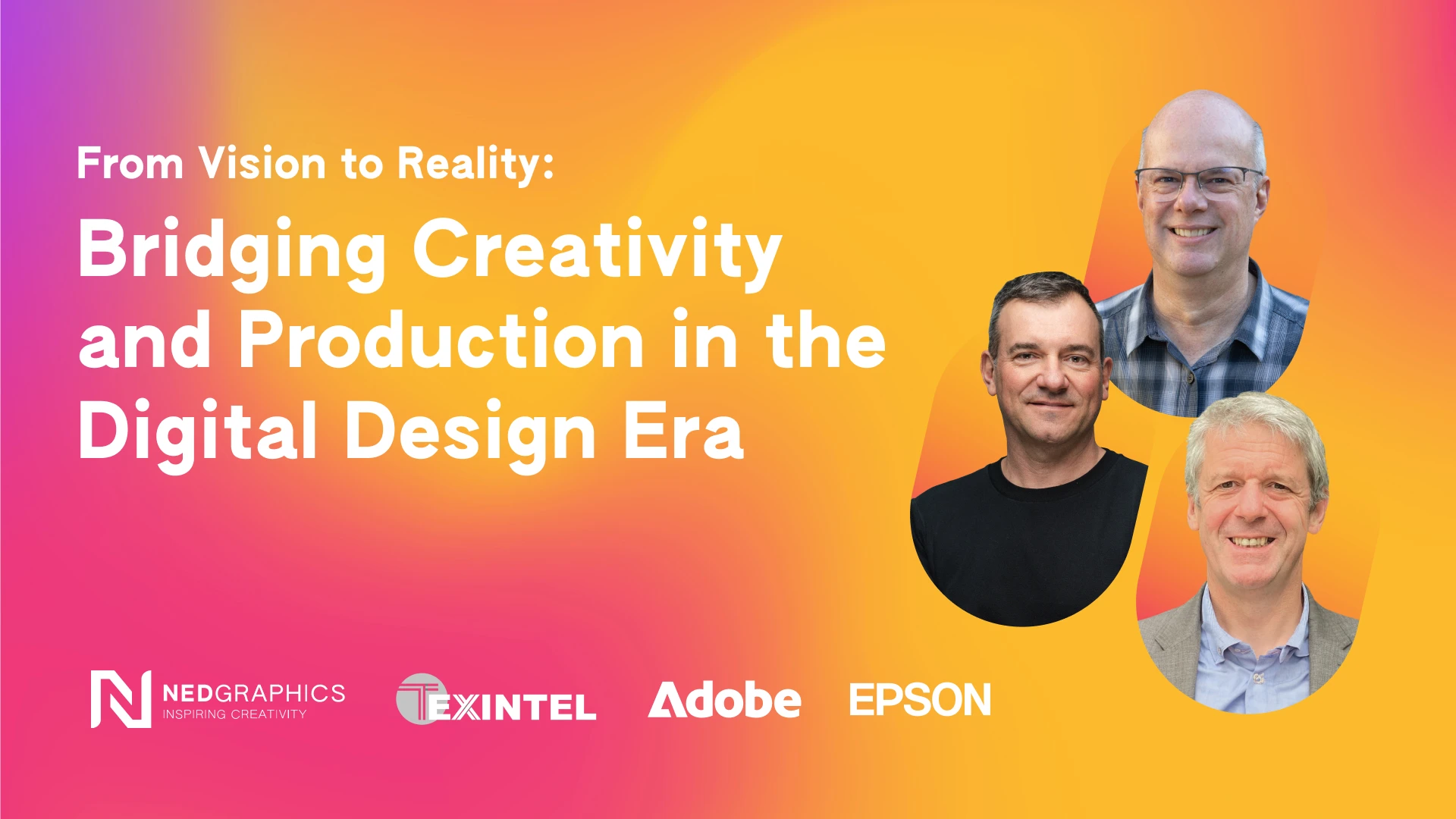What happens when a designer’s vision meets the complexity of global production?

A pattern imagined in New York might be printed in Shanghai and sold in Milan. Along the way, creative intent can get lost, colors can shift, and final products can look very different from what was originally envisioned. As design workflows become more digital and supply chains more distributed, the challenge is no longer just about creating something beautiful. It is about ensuring that what is designed is exactly what is delivered.
At a recent roundtable discussion, leaders from NedGraphics, Adobe®, and Epson explored this challenge in depth. Together, they examined how innovation in digital design software, color management, and connected workflows is helping designers protect their vision while accelerating production, improving accuracy, and enabling new creative possibilities.
“For centuries, textile design was a manual art form,” explained Frank Maeder, President of NedGraphics. “Our software is essentially digitizing processes that designers have been perfecting for hundreds of years. What is changing now is the scale and complexity of production.”
The creative process itself has not fundamentally changed. Designers are still imagining, sketching, and refining patterns and styles. However, their work now travels across continents and through dozens of hands before reaching consumers. Brands increasingly design in one country, produce in another, and sell globally. With every handoff, the risk of losing creative intent grows.
NedGraphics focuses on preserving that intent by giving designers tools to visualize accurately, collaborate across teams, and seamlessly pass their work downstream to printers and manufacturers. As Frank noted, the reality of global supply chains means software alone is not enough:

“Designers need confidence that what they create will look the same when it comes off the production line, whether it is printed in New York, Shanghai, or Milan.”
Mike Scrutton, Director of Print Technology and Strategy at Adobe, highlighted one of the most pressing challenges in the digital design world: how to maintain creative intent when designs are reproduced across countless devices, technologies, and locations. “In the past, designers knew exactly how their work would be manufactured,” Mike explained.

“They prepared files for specific machines and workflows. Today, designs are reproduced across multiple technologies, often without the designer knowing which device or process will be used.”
If design intent is the vision, color accuracy is the heartbeat.
Duncan Ferguson, VP of Commercial & Industrial Printing at Epson Europe, explained the challenge:

“Color reproduction is one of the biggest hurdles we face. Consumers expect that what they see on-screen is what they will get in their hands. The journey from RGB to CMYK to fabric is rarely straightforward.”
To bridge this gap, Epson focuses on two things:
By combining advanced drop control with an expanded ink gamut and integrated spectrophotometer technology, Epson makes color management more predictable and accessible. While a wider gamut expands creative potential, precise dot placement defines tonal quality and image smoothness. These technologies capture accurate color data at the start and preserve it throughout production, giving designers, printers, and manufacturers a more reliable baseline to work from.
This ultimately gives designers and businesses greater consistency and confidence across multiple devices, materials, and locations. In a world where production often spans continents, Epson’s solutions aim to simplify the process and reduce uncertainty, helping bring the designer’s original vision closer to reality.
Throughout the discussion, one theme kept emerging: digital transformation is not just about tools. It is about relationships.
For decades, the textile and printing industries operated in silos. Designers created, manufacturers executed, and printers handled output, often without sharing data or workflows. That is changing rapidly.
Brands are now forming cross-functional optimization teams, technology vendors are opening their platforms to integrate seamlessly, and digital workflows are dissolving old barriers.

“The industry is shifting from proprietary, closed systems to open collaboration,” Frank noted. “When designers, manufacturers, and software providers work together, we unlock speed, accuracy, and creative freedom.”
One of the most exciting outcomes of this digital transformation is how it is reshaping sustainability and speed-to-market. Brands are no longer constrained by traditional, linear workflows. By embedding fully connected digital processes from design through production, they are transforming how products are imagined, manufactured, and delivered.
This shift allows brands to significantly reduce waste by using virtual sampling and precise 3D simulation to eliminate unnecessary test prints and prototypes. It also enables smarter, localized manufacturing, bringing production closer to the point of sale. The result is fewer air miles, faster response times, and a lower environmental impact, all while giving brands the flexibility to respond to consumer demand in real time. On-demand production is also becoming a reality, making it possible to create smaller, more targeted runs without sacrificing speed or quality.
The panelists also explored emerging technologies like digital twins and touchless production pipelines, which make these advancements possible. A single design file can now carry every detail required to manufacture a product accurately, from color specifications and material choices to finishing instructions, while minimizing the need for human intervention. This creates a seamless connection between design and production, reducing bottlenecks and errors while increasing confidence in the final result.
The vision is bold: a future where designers create without limits, brands deliver with certainty, and manufacturers produce sustainably and efficiently. This is not just an improvement in workflows. It represents a fundamental shift in how products are conceived, developed, and brought to market.
As the roundtable concluded, the experts agreed on one thing: the next era of digital design will be defined by integration and trust.
“We are on the dawn of a whole new landscape,” Duncan said. “It is not about solving problems in isolation anymore. It is about connecting every step of the process.”
From NedGraphics’ creative tools to Adobe’s precision workflows to Epson’s advanced color technology, the message is clear: when software, hardware, and human expertise work together, designers gain the freedom to innovate without compromise.
Digital transformation is not replacing the artistry of design. It is amplifying it. By uniting creativity, data, and production into a single connected ecosystem, the industry is entering an era where designers can set trends, influence culture, and deliver flawlessly executed products at the speed of global demand.
A special thanks goes to Debbie McKeegan, Host and Moderator from Texintel, for leading this insightful roundtable and bringing together perspectives from across the digital design landscape. We are proud to have NedGraphics at the forefront of this innovation, helping designers, brands, and manufacturers reimagine their workflows with tools that make creativity seamless, accurate, and scalable.
If you are ready to elevate your design process and deliver products with greater precision, speed, and confidence, connect with the NedGraphics team to explore how our solutions can transform the way you create.
Are you interested in watching the round table? Watch it here
The future of digital design is here. Let’s build it together.
– Your NedGraphics Team

Please wait while you are redirected to the right page...